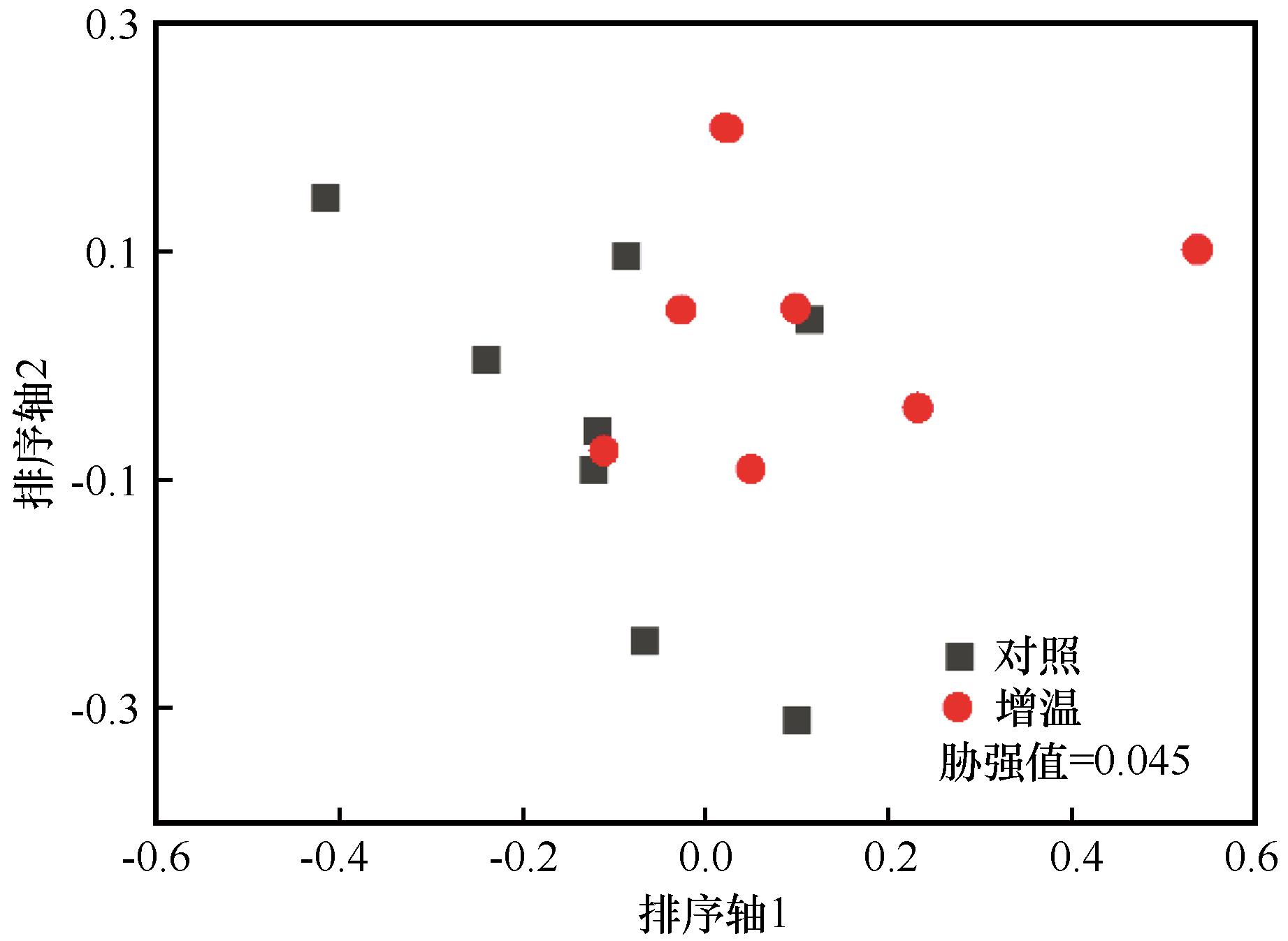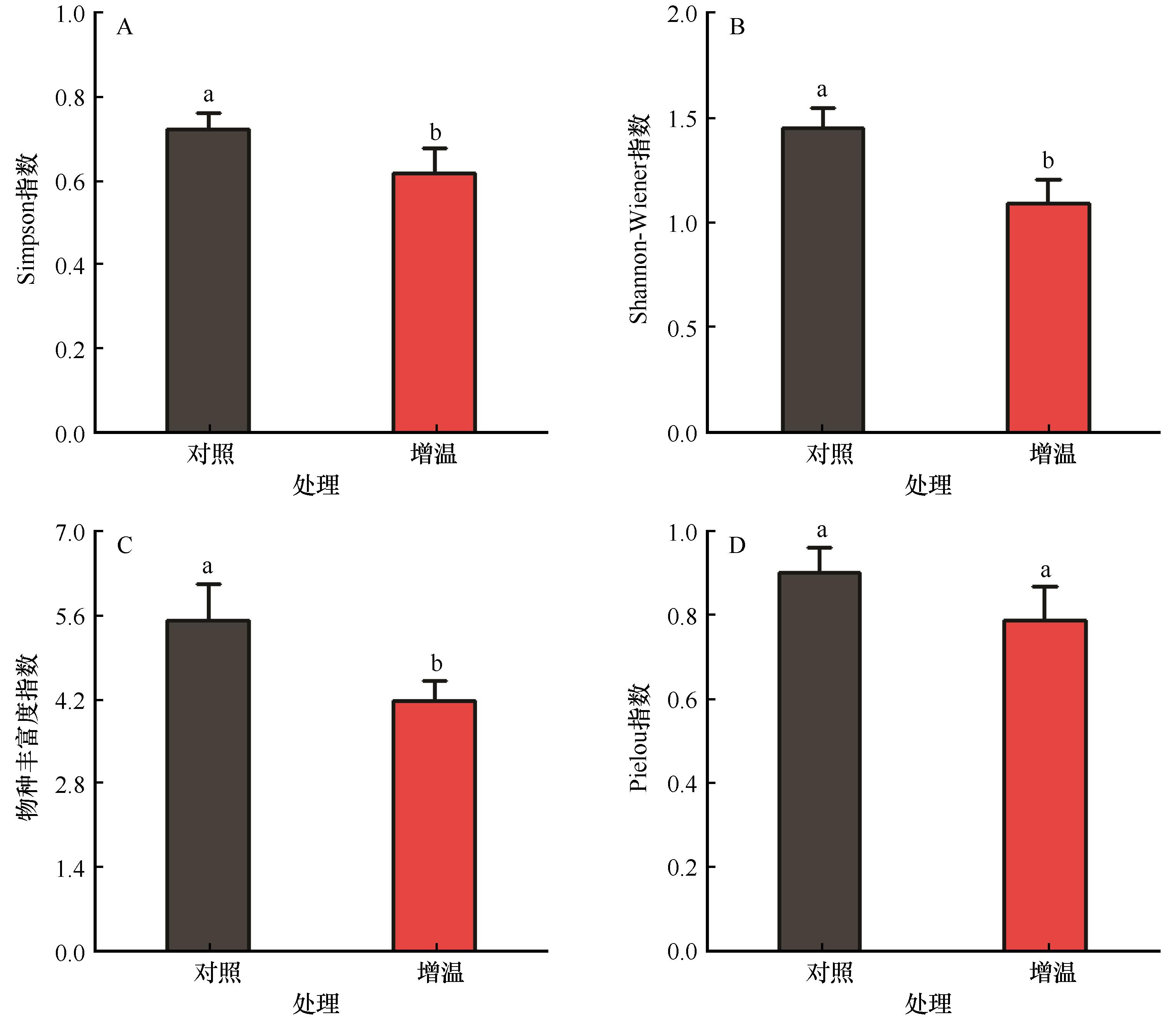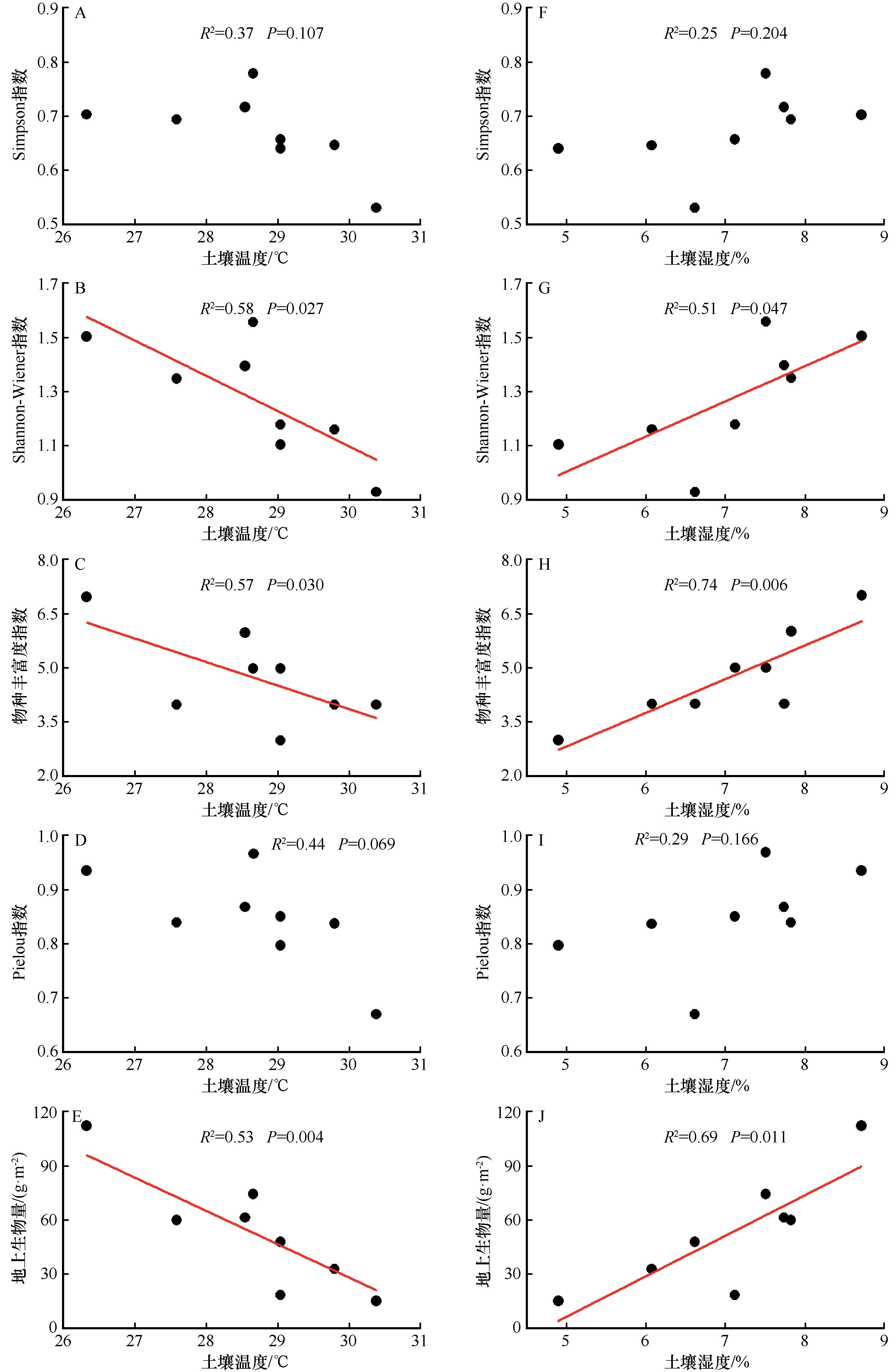
- CN 62-1070/P
- ISSN 1000-694X
- Bimonthly 1981

Journal of Desert Research ›› 2024, Vol. 44 ›› Issue (1): 151-160.DOI: 10.7522/j.issn.1000-694X.2023.00073
Previous Articles Next Articles
Tianling Bao1,3( ), Jiliang Liu2,3, Feng Yuan4, Yinlong Li5, Zhenyu Jia6, Chengchen Pan1,3(
), Jiliang Liu2,3, Feng Yuan4, Yinlong Li5, Zhenyu Jia6, Chengchen Pan1,3( )
)
Received:2023-05-22
Revised:2023-07-03
Online:2024-01-20
Published:2023-12-26
Contact:
Chengchen Pan
CLC Number:
Tianling Bao, Jiliang Liu, Feng Yuan, Yinlong Li, Zhenyu Jia, Chengchen Pan. Response of plant community to experimental warming in Horqin Sandy Land[J]. Journal of Desert Research, 2024, 44(1): 151-160.
Add to citation manager EndNote|Ris|BibTeX
URL: http://www.desert.ac.cn/EN/10.7522/j.issn.1000-694X.2023.00073
| 处理 | 土壤温度/℃ | 土壤湿度/% |
|---|---|---|
| 对照 | 14.59±0.31 | 1.62±0.06 |
| 增温 | 15.38±0.30 | 1.49±0.03 |
Table 1 Soil temperature and moisture at the surface 10 cm in open-top chamber (OTC)
| 处理 | 土壤温度/℃ | 土壤湿度/% |
|---|---|---|
| 对照 | 14.59±0.31 | 1.62±0.06 |
| 增温 | 15.38±0.30 | 1.49±0.03 |
| 科 | 种 | 生活型 | 重要值 | |
|---|---|---|---|---|
| 对照 | 增温 | |||
| 菊科 | 黄蒿(Artemisia scoparia) | 多年生草本 | 0.20±0.05 | 0.24±0.05* |
| 大籽蒿(Artemisia sieversiana) | 多年生草本 | 0.15±0.05 | 0.06±0.03 | |
| 艾蒿(Artemisia argyi) | 多年生草本 | — | 0.02±0.01 | |
| 禾本科 | 糙隐子草(Cleistogenes squarrosa) | 多年生草本 | 0.01±0.01 | 0.15±0.07* |
| 狗尾草(Setaria viridis) | 一年生草本 | 0.40±0.06 | 0.28±0.06* | |
| 白草(Pennisetum centrasiaticum) | 多年生草本 | 0.02±0.01 | 0.02±0.01 | |
| 画眉(Eragrostis pilosa) | 一年生草本 | 0.01±0.01 | — | |
| 芦苇(Phragmites australis) | 多年生草本 | 0.08±0.05 | — | |
| 藜科 | 雾冰藜(Bassia dasyphylla) | 一年生草本 | 0.01±0.01 | — |
| 猪毛菜(Salsola collina) | 一年生草本 | 0.05±0.02 | 0.05±0.02 | |
| 虫实(Corispermum hyssopifolium) | 一年生草本 | — | 0.03±0.02 | |
| 蒺藜科 | 蒺藜(Tribulus terrester) | 一年生草本 | 0.04±0.01 | 0.13±0.05 |
| 紫草科 | 砂引草(Tournefortia sibirica) | 多年生草本 | 0.02±0.01 | 0.02±0.01 |
| 苋科 | 反枝苋(Amaranthus retroflexus) | 一年生草本 | 0.01±0.01 | — |
| 马齿苋科 | 马齿苋(Portulaca oleracea) | 一年生草本 | 0.01±0.01 | — |
Table 2 Changes of important values of species at warming and control treatments of Horqin Sandy Land
| 科 | 种 | 生活型 | 重要值 | |
|---|---|---|---|---|
| 对照 | 增温 | |||
| 菊科 | 黄蒿(Artemisia scoparia) | 多年生草本 | 0.20±0.05 | 0.24±0.05* |
| 大籽蒿(Artemisia sieversiana) | 多年生草本 | 0.15±0.05 | 0.06±0.03 | |
| 艾蒿(Artemisia argyi) | 多年生草本 | — | 0.02±0.01 | |
| 禾本科 | 糙隐子草(Cleistogenes squarrosa) | 多年生草本 | 0.01±0.01 | 0.15±0.07* |
| 狗尾草(Setaria viridis) | 一年生草本 | 0.40±0.06 | 0.28±0.06* | |
| 白草(Pennisetum centrasiaticum) | 多年生草本 | 0.02±0.01 | 0.02±0.01 | |
| 画眉(Eragrostis pilosa) | 一年生草本 | 0.01±0.01 | — | |
| 芦苇(Phragmites australis) | 多年生草本 | 0.08±0.05 | — | |
| 藜科 | 雾冰藜(Bassia dasyphylla) | 一年生草本 | 0.01±0.01 | — |
| 猪毛菜(Salsola collina) | 一年生草本 | 0.05±0.02 | 0.05±0.02 | |
| 虫实(Corispermum hyssopifolium) | 一年生草本 | — | 0.03±0.02 | |
| 蒺藜科 | 蒺藜(Tribulus terrester) | 一年生草本 | 0.04±0.01 | 0.13±0.05 |
| 紫草科 | 砂引草(Tournefortia sibirica) | 多年生草本 | 0.02±0.01 | 0.02±0.01 |
| 苋科 | 反枝苋(Amaranthus retroflexus) | 一年生草本 | 0.01±0.01 | — |
| 马齿苋科 | 马齿苋(Portulaca oleracea) | 一年生草本 | 0.01±0.01 | — |

Fig.2 Non-metric multidimensional scaling (NMDS) plot indicating 2-dimensional of aboveground biomass of plant communities at warming and control treatments of Horqin Sandy Land

Fig.3 The changes of Simpson's index, Shannon-Wiener index, species richness index and Pielou's index of plant community at warming and control treatments of Horqin Sandy Land
| 处理 | 节点数 | 总连接数 | 平均连接度 | 聚集系数 | 连通性 | 模块化指数 |
|---|---|---|---|---|---|---|
| 对照 | 13 | 72 | 5.538 | 0.913 | 0.900 | 0.185 |
| 增温 | 10 | 44 | 4.400 | 0.978 | 1.002 | 0.056 |
Table 3 Topological properties of species interaction networks at warming and control treatments of Horqin Sandy Land
| 处理 | 节点数 | 总连接数 | 平均连接度 | 聚集系数 | 连通性 | 模块化指数 |
|---|---|---|---|---|---|---|
| 对照 | 13 | 72 | 5.538 | 0.913 | 0.900 | 0.185 |
| 增温 | 10 | 44 | 4.400 | 0.978 | 1.002 | 0.056 |

Fig.6 Relationships between species richness, Simpson index, Shannon-Wiener index, Pielou index and aboveground biomass of plant community and soil temperature, moisture
| 1 | Zhou D, Xiao J,Frolking,et al.Urbanization contributes little to global warming but substantially intensifies local and regional land surface warming[J].Earths Future,2022,10(5):e2021EF002401. |
| 2 | Kumar R, Sharma A.A review of atmospheric changes amidst COVID19 pandemic in the light of IPCC special report 2018 and COP24 conference[J].UPJOZ,2020,41:1-8. |
| 3 | Risbey J S, Grose M R, Monselesan D P,et al.Transient response of the global mean warming rate and its spatial variation[J].Weather and Climate Extremes,2017,18:55-64. |
| 4 | Jing X, Sanders N J, Shi Y,et al.The links between ecosystem multifunctionality and above-and belowground biodiversity are mediated by climate[J].Nature Communications,2015,6(1):8159. |
| 5 | Oreskes N.Beyond the ivory tower:the scientific consensus on climate change[J].Science,2004,306(5702):1686. |
| 6 | Ganjurjav H, Gao Q, Gornish E S,et al.Differential response of alpine steppe and alpine meadow to climate warming in the central Qinghai-Tibetan Plateau[J].Agricultural and Forest Meteorology,2016,223:233-240. |
| 7 | 孙小丽,康萨如拉,张庆,等.荒漠草原物种多样性、生产力与气候因子和土壤养分之间关系的研究[J].草业学报,2015,24(12):10-19. |
| 8 | 脱登峰,卢琦,却晓娥,等.中国北方草地生态系统服务评估[J].生态学报,2023,43(2):1-8. |
| 9 | 陈安群,张露娜,柴诗杰,等.非生长季放牧对黄河上游草甸种子产量的影响[J].河南师范大学学报,2022,50(6):45-52. |
| 10 | Ma Z, Liu H, Mi Z,et al.Climate warming reduces the temporal stability of plant community biomass production[J].Nature Communications,2017,8(1):15378. |
| 11 | 李娜,王根绪,杨燕,等.短期增温对青藏高原高寒草甸植物群落结构和生物量的影响[J].生态学报,2011,31(4):895-905. |
| 12 | 姜炎彬,范苗,张扬建.短期增温对藏北高寒草甸植物群落特征的影响[J].生态学杂志,2017,36(3):616-622. |
| 13 | Ma Y D, Zhen Q Z, Zhang Y,et al.Responses of plant community structure to mowing in the degraded alpine meadows,Northwestern Yunnan Province[J].Acta Ecologica Sinica,2022,42(19):233-242. |
| 14 | Zhang Y, Gao Q, Ganjurjav H,et al.Grazing exclusion changed the complexity and keystone species of alpine meadows on the Qinghai-Tibetan Plateau[J].Frontiers in Ecology and Evolution,2021,9:638157. |
| 15 | 赵文智,刘鹄.干旱、半干旱环境降水脉动对生态系统的影响[J].应用生态学报,2011,22(1):243-249. |
| 16 | 孙一梅,田青,吕朋,等.极端干旱与氮添加对半干旱沙质草地物种多样性、叶性状和生产力的影响[J].干旱区研究,2020,37(6):1569-1579. |
| 17 | 赵哈林,大黑俊哉,李玉霖,等.人类放牧活动与气候变化对科尔沁沙质草地植物多样性的影响[J].草业学报,2008,17(5):1-8. |
| 18 | 王明明,刘新平,何玉惠,等.科尔沁沙质草地生物量积累过程对降水变化的响应模拟[J].生态学报,2020,40(11):3656-3665. |
| 19 | 刘媛媛.1989-2018年奈曼旗气温变化特征分析[J].现代农业科技,2019,748(14):193-194. |
| 20 | 赵珍珍.基于多源数据的科尔沁沙地生态环境变化研究[D].武汉:武汉大学,2017. |
| 21 | 赵哈林,李瑾,周瑞莲,等.不同强度净风频繁吹袭对樟子松(Pinus sylvestris var.mongolica)幼苗光合蒸腾特征的影响[J].生态学报,2017,37(5):1431-1437. |
| 22 | 詹瑾,韩丹,杨红玲,等.科尔沁沙地植被恢复过程中群落组成及多样性演变特征[J].中国沙漠,2022,42(2):194-206. |
| 23 | 郭倩.草地群落植物种等级划分及重要值方法改进[D].兰州:兰州大学,2017. |
| 24 | 吴红宝,高清竹,干珠扎布,等.放牧和模拟增温对藏北高寒草地植物群落特征及生产力的影响[J].植物生态学报,2019,43(10):853-862. |
| 25 | Clarke K.Nonparametric multivariate analyses of changes in community structure[J].Australian Journal of Ecology,1993,18(1):117-143. |
| 26 | Montoya J M, Pimm S L, Sole R V.Ecological networks and their fragility[J].Nature,2006,442(7100):259-264. |
| 27 | Bascompte J.Networks in ecology[J].Basic and Applied Ecology,2007,8(6):485-490. |
| 28 | 石文莉,蒋如东,马天海,等.太湖不同营养水平湖区沉积环境微生物分子生态网络特征及其环境响应分析[J].南京大学学报(自然科学版),2018,54(5):1045-1056. |
| 29 | Hale S L, Koprowski J L.Ecosystem-level effects of keystone species reintroduction:a literature review[J].Restoration Ecology,2018,26(3):439-445. |
| 30 | 胡冬,吕光辉,王恒方,等.水分梯度下荒漠植物多样性与稳定性对土壤因子的响应[J].生态学报,2021,41(17):6738-6748. |
| 31 | 孙岩,何明珠,王立.降水控制对荒漠植物群落物种多样性和生物量的影响[J].生态学报,2018,38(7):2425-2433. |
| 32 | Zhao J, Luo T, Li R,et al.Precipitation alters temperature effects on ecosystem respiration in Tibetan alpine meadows[J].Agricultural and Forest Meteorology,2018,252:121-129. |
| 33 | 吕朋,左小安,岳喜元,等.科尔沁沙地封育过程中植被特征的动态变化[J].生态学杂志,2018,37(10):2880-2888. |
| 34 | Luo W, Griffin-Nolan R J, Ma W,et al.Plant traits and soil fertility mediate productivity losses under extreme drought in C-3 grasslands[J].Ecology,2021,102(10):e03465. |
| 35 | 吉使阿微,赵文学,肖颖,等.短期增温对川西北高寒草甸植物群落结构和叶片性状的影响[J].草地学报,2022,30(12):3402-3409. |
| 36 | Gedan K B, Bertness M D.Experimental warming causes rapid loss of plant diversity in New England salt marshes[J].Ecology Letters,2009,12(8):842-848. |
| 37 | Prieto P, Penuelas J, Lloret F,et al.Experimental drought and warming decrease diversity and slow down post-fire succession in a Mediterranean shrubland[J].Ecography,2009,32(4):623-636. |
| 38 | 郭轶瑞,赵哈林,左小安,等.科尔沁沙地生物结皮的土壤种子库特征[J].水土保持学报,2007,21(6):187-191. |
| 39 | 赵啸龙,谢玉鸿,马旭君,等.科尔沁沙质草地不同恢复年限草本层群落结构及其与土壤理化性质的关系[J].中国沙漠,2022,42(2):134-141. |
| 40 | 刘银占,陈安群,郭京伟,等.气候变暖与管理方式对草地群落影响研究综述[J].河南师范大学学报,2023,51(1):130-137. |
| 41 | 郭轶瑞,赵哈林,赵学勇,等.科尔沁沙质草地物种多样性与生产力的关系[J].干旱区研究,2007,24(2):198-203. |
| 42 | Arndal M F, Tolver A, Larsen K S,et al.Fine root growth and vertical distribution in response to elevated CO2,warming and drought in a mixed heathland-grassland[J].Ecosystems,2018,21(1):15-30. |
| 43 | Grime J P, Grime J P.Plant Strategies,Vegetation Processes,and Ecosystem Properties[M].New York,USA:Wiley,2001. |
| 44 | Rome A.The closing circle:nature,man,and technology[J].Nature,2015,527(7579):443-445. |
| 45 | 刘小丹,李瑞,张克斌,等.半干旱区人工封育草场植物群落物种多样性与复杂性研究:以宁夏盐池为例[J].生态环境学报,2014,23(7):1093-1101. |
| 46 | 袁梓裕,张路,廖李容,等.黄土高原草地植物多样性与群落稳定性的关系及其驱动因素[J].生态学报,2023,43(1):60-69. |
| 47 | Meyer J M, Leempoel K, Losapio G,et al.Molecular ecological network analyses:an effective conservation tool for the assessment of biodiversity,trophic interactions,and community structure[J].Frontiers in Ecology and Evolution,2020,8:588430. |
| [1] | Xinyang Li, Peiji Shi, Junfeng Yin, Yali Li, Wenshun Cai. Research on structural characteristics and optimization of tourism flow network in Hexi Corridor [J]. Journal of Desert Research, 2023, 43(4): 135-145. |
| [2] | Kaiyuan Gan, Jinxia Zhang, Lijuan Chen, Haiyang Xi, Binwu Zhang, Tian Yong, Yuxi Wei. Characteristics and spatial differentiation of plant communities along the Yellow River in the Ulan Buh Desert [J]. Journal of Desert Research, 2023, 43(4): 180-190. |
| [3] | Bingjie Jiao, Bingchang Zhang, Kang Zhao, Lixia Yan, Zhifang Wu. Promoting effect of biological soil crusts succession on soil nitrogen transformation and microbial activity in water-wind erosion crisscross region of Loess Plateau [J]. Journal of Desert Research, 2023, 43(4): 191-199. |
| [4] | Yu Ren, Bo Zhang, Xidong Chen. Desertification sensitivity assessment in Horqin Sandy Land [J]. Journal of Desert Research, 2023, 43(2): 159-169. |
| [5] | Lingfei Zhong, Lihua Zhang. Changes in temperature and precipitation in the plain area of Hexi Corridor in 2000-2020 [J]. Journal of Desert Research, 2023, 43(2): 264-270. |
| [6] | Peiyuan Wang, Haotian Yang, Xue Zhang, Bingqing Liu, Yunfei Li, Qi Jiang, Zhanjun Wang, Xudong Wu, Lichao Liu. Response of module biomass allocation of Agropyron mongolicum var. mongolicum to soil types [J]. Journal of Desert Research, 2023, 43(2): 74-84. |
| [7] | Juntuan Zhai, Xiangxiang Chen, Xiu Li, Shanhe Zhang, Xiaoli Han, Zhijun Li. Sexual dimorphism in allometric growth relationship between branch and leaf traits of Populus euphratica with changes in developmental stage and canopy height [J]. Journal of Desert Research, 2023, 43(1): 116-127. |
| [8] | Meng Yan, Xuyang Wang, Liye Zhou, Yuqiang Li. Characteristics and influencing factors of soil organic carbon in the process of desertification in Horqin Sandy Land [J]. Journal of Desert Research, 2022, 42(5): 221-231. |
| [9] | Xiaole Li, Xiaohong Dang, Bo Zhai, Yajuan Wei, Xu Chi, Huimin Wu. Adventitious root architecture and growth characteristics of Nitraria tangutorum shrub [J]. Journal of Desert Research, 2022, 42(4): 172-180. |
| [10] | Chao He, Tingxi Liu, Limin Duan, Guanli Wang, Lina Hao. Water use characteristics of typical plant Artemisia halodendron in Horqin Sandy Land [J]. Journal of Desert Research, 2022, 42(4): 190-198. |
| [11] | Yiran Zhang, Tingxi Liu, Xin Tong, Limin Duan, Tianyu Jia, Yaxin Ji. Inversion of vegetation coverage based on multi-source remote sensing data and machine learning method in the Horqin Sandy Land, China [J]. Journal of Desert Research, 2022, 42(3): 187-195. |
| [12] | Huaihai Wang, Wenda Huang, Yuanzheng He, Yayi Niu, Yuanzhong Zhu. Effects of short-term warming and precipitation reduction on soil microbial biomass carbon, nitrogen and enzyme activity in sandy grassland [J]. Journal of Desert Research, 2022, 42(3): 274-281. |
| [13] | Xiaolong Zhao, Yuhong Xie, Xujun Ma, Shaokun Wang. Vegetation structure and its relationship with soil physicochemical properties in restoring sandy grassland in Horqin Sandy Land [J]. Journal of Desert Research, 2022, 42(2): 134-141. |
| [14] | Xinxin Guo, Ping Yue, Xiangyun Li, Jingjuan Qiao, Ya Hu, Xiaoan Zuo. Effects of precipitation on above-ground biomass of Peganum harmala in desert steppe in Inner Mongolia, China [J]. Journal of Desert Research, 2022, 42(2): 164-172. |
| [15] | Jin Zhan, Dan Han, Hongling Yang, Yulin Li. Evolution characteristics of vegetation community composition and diversity during the restoration of Horqin Sandy Land in 2005-2019 [J]. Journal of Desert Research, 2022, 42(2): 194-206. |
| Viewed | ||||||
|
Full text |
|
|||||
|
Abstract |
|
|||||
©2018Journal of Desert Research
Tel:0931-8267545
Email:caiedit@lzb.ac.cn;desert@lzb.ac.cn
Support:Magtech